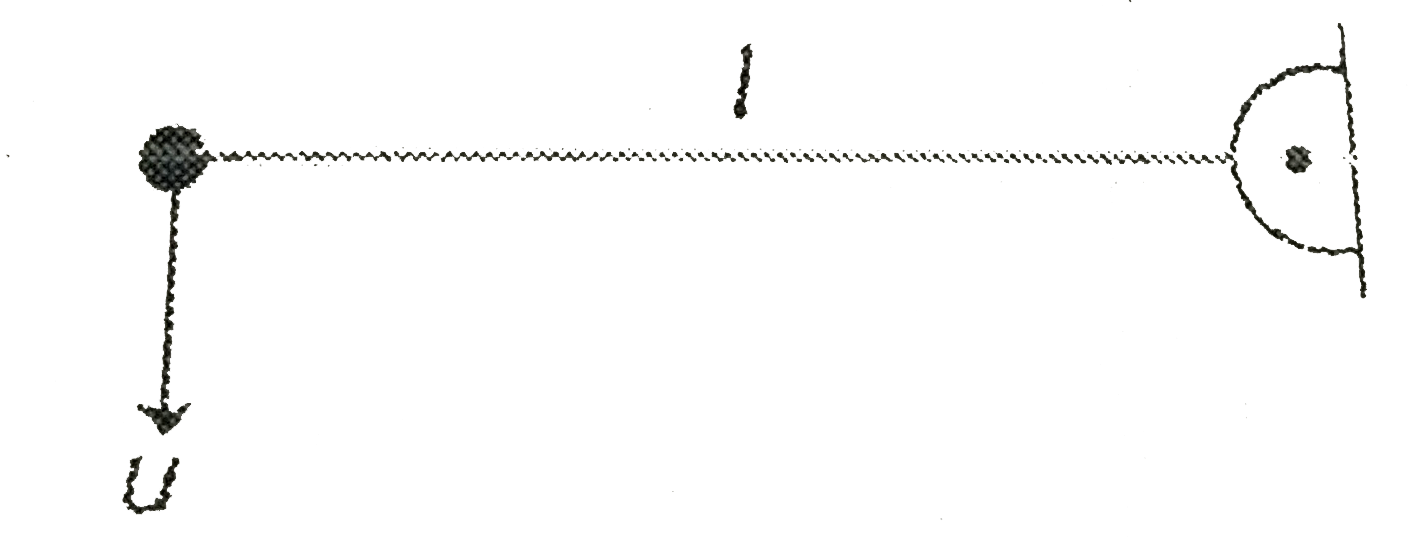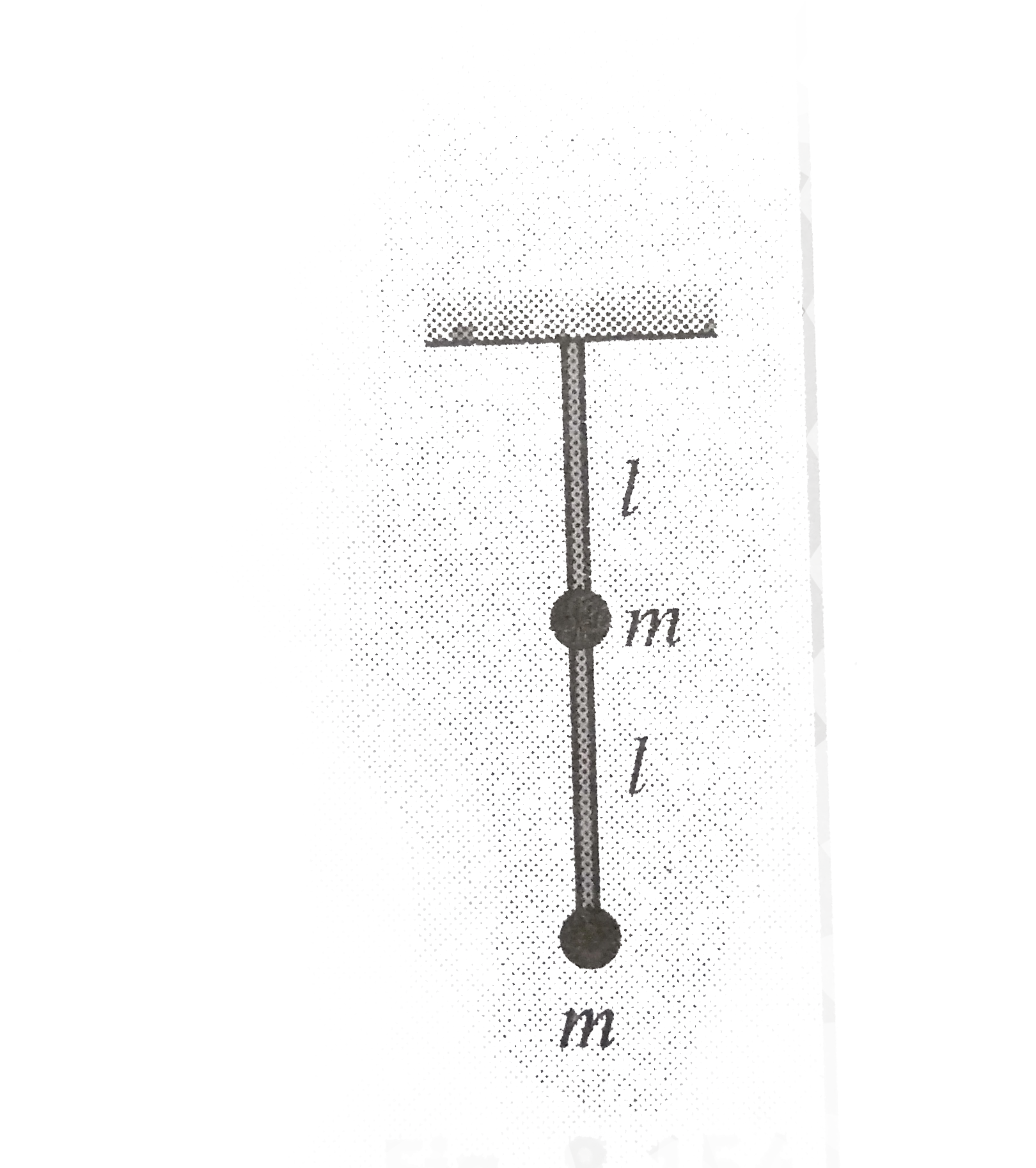A light rod length L, is hanging from the vertical smooth wall of a vehicle moving with acceleration √3g having a small mass attached at its one end is free to rotate about an axis passing through the other end. The minimum velocity given to the mass at its equilibrium position with respect to vehicle so that it can complete vertical circular motion respect to vehical) is √KgL. Find the value of K.
√5gL
√4gL
√8gL
None of these
The correct Answer is:C
To solve the problem, we need to determine the minimum velocity that a mass attached to a light rod must have at its equilibrium position in order to complete a vertical circular motion with respect to a vehicle that is accelerating.
1. Understanding the System:
- We have a light rod of length L hanging from a vertical smooth wall of a vehicle.
- The vehicle is moving with an acceleration a=√3g.
- A small mass m is attached to one end of the rod, which can rotate about the other end (the pivot).
2. Effective Gravity:
- The effective acceleration acting on the mass due to the vehicle's acceleration and gravity can be calculated using vector addition.
- The gravitational acceleration g acts downwards, and the vehicle's acceleration √3g acts horizontally.
- The effective gravitational acceleration geffective can be found using:
geffective=√g2+(√3g)2
- Simplifying this gives:
geffective=√g2+3g2=√4g2=2g
3. Minimum Velocity for Vertical Circular Motion:
- For an object to complete a vertical circular motion, the minimum velocity at the top of the circle must be such that the gravitational force provides the necessary centripetal force.
- The centripetal force required at the top of the circle is given by:
Fc=mv2L
- At the top of the circle, the gravitational force acting on the mass is mgeffective.
- For the mass to just complete the circular motion, we set the centripetal force equal to the gravitational force:
mv2L=mgeffective
- Substituting geffective=2g:
mv2L=m(2g)
- Canceling m from both sides (assuming m≠0):
v2L=2g⇒v2=2gL
4. Finding the Minimum Velocity:
- The minimum velocity v at the bottom of the circular path (equilibrium position) can be found using energy conservation or dynamics.
- The velocity required to maintain circular motion at the bottom is given by:
v2min=4geffectiveL
- Substituting geffective=2g:
v2min=4(2g)L=8gL
- Thus, the minimum velocity vmin is:
vmin=√8gL
5. Finding the Value of K:
- We are given that the minimum velocity can be expressed as vmin=√KgL.
- From our calculation, we have:
√KgL=√8gL
- Squaring both sides gives:
KgL=8gL
- Dividing both sides by gL (assuming gL≠0):
K=8
Final Answer:
The value of K is 8.
- We have a light rod of length L hanging from a vertical smooth wall of a vehicle.
- The vehicle is moving with an acceleration a=√3g.
- A small mass m is attached to one end of the rod, which can rotate about the other end (the pivot).
- The effective acceleration acting on the mass due to the vehicle's acceleration and gravity can be calculated using vector addition.
- The gravitational acceleration g acts downwards, and the vehicle's acceleration √3g acts horizontally.
- The effective gravitational acceleration geffective can be found using:
geffective=√g2+(√3g)2
- Simplifying this gives:
geffective=√g2+3g2=√4g2=2g
- For an object to complete a vertical circular motion, the minimum velocity at the top of the circle must be such that the gravitational force provides the necessary centripetal force.
- The centripetal force required at the top of the circle is given by:
Fc=mv2L
- At the top of the circle, the gravitational force acting on the mass is mgeffective.
- For the mass to just complete the circular motion, we set the centripetal force equal to the gravitational force:
mv2L=mgeffective
- Substituting geffective=2g:
mv2L=m(2g)
- Canceling m from both sides (assuming m≠0):
v2L=2g⇒v2=2gL
- The minimum velocity v at the bottom of the circular path (equilibrium position) can be found using energy conservation or dynamics.
- The velocity required to maintain circular motion at the bottom is given by:
v2min=4geffectiveL
- Substituting geffective=2g:
v2min=4(2g)L=8gL
- Thus, the minimum velocity vmin is:
vmin=√8gL
- We are given that the minimum velocity can be expressed as vmin=√KgL.
- From our calculation, we have:
√KgL=√8gL
- Squaring both sides gives:
KgL=8gL
- Dividing both sides by gL (assuming gL≠0):
K=8
The value of K is 8.
Similar Questions
A particle of mass of mass m is attached to a light rod of lenght l other end of the rod is hinged to a wall . Minimumm velocity (Vo) that should be given to a particle in lowest positiion so that it completes a vertical circle
View SolutionFind the moment of inertia A of a spherical ball of mass m and radius r attached at the end of a straight rod of mass M and length l, if this system is free to rotate about an axis passing through the end of the rod (end of the rod opposite to sphere).

View Solution
Knowledge Check
The radius of gyration of an uniform rod of length l about an axis passing through one of its ends and perpendicular to its length is.
Al√2Bl3Cl√3Dl2
A ball of mass m is attached to one end of a light rod of length l, the other end of which is hinged. What minimum velocity v should be imparted to the ball downwards, so that it can complete the circle ?

View SolutionTwo point masses m are connected the light rod of length l and it is free to rotate in vertical plane as shown in figure. Calculate the minimum horizontal velocity is given to mass so that it completes the circular motion in vertical lane.

View SolutionA uniform rod of mass m and length L is free to rotate in the vertical plane about a horizontal axis passing through its end. The rod initially in horizontal position is released. The initial angular acceleration of the rod is:

View Solutionfind the radius of gyration of a rod of mass m and length 2l about an axis passing through one of its ends and perpendicular to its length.
View SolutionThe moment of inertia of a straight thin rod of mass M and length l about an axis perpendicular to its length and passing through its one end, is
View SolutionA thin uniform wire of mass m and length l is bent into to shape of a semicircle. The moment of inertia of that wire about an axis passing through its free ends is
View SolutionA rod of mass M and length l attached with a small bob of mass m at its end is freely rotating about a vertical axis passing through its other end with a constant angular speed ω. Find the force exerted by the system (rod and bob) on the pivot. Assume that gravity is absent.
View Solution
